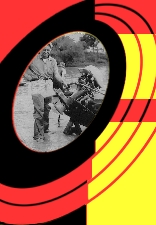Overview of Outdoor Activity
Lockwood-AshRowboat Motor
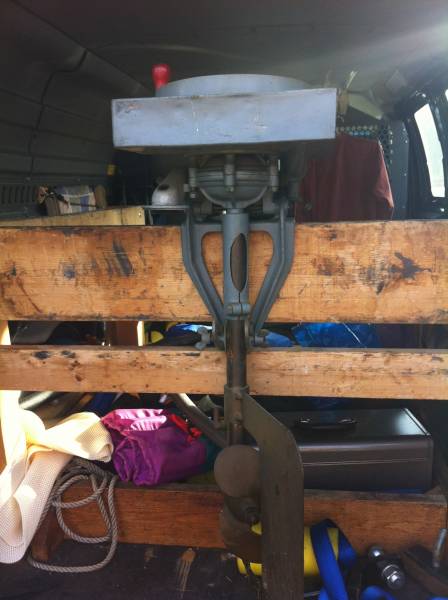 |
Note the rudder steering.
|
Concours Koban Twin
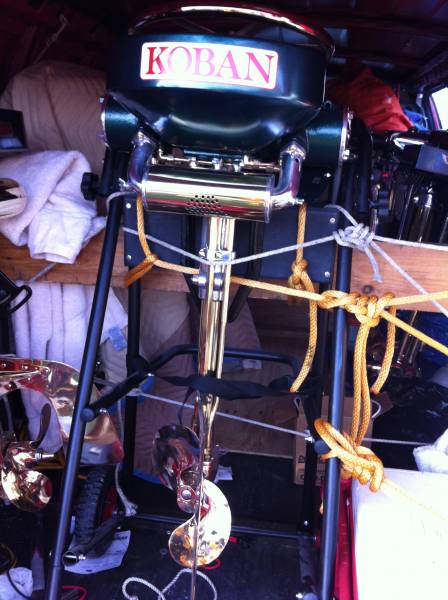 |
Koban is credited with making the first 2-cylinder outboard in this country.
|
Concours Johnson Single Motor
Elto Twin
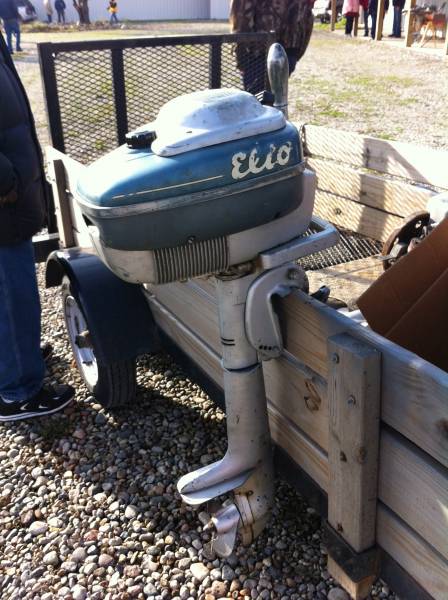 |
Elto Twin made by Gale Division of OMC
|
Elto Ruddertwin
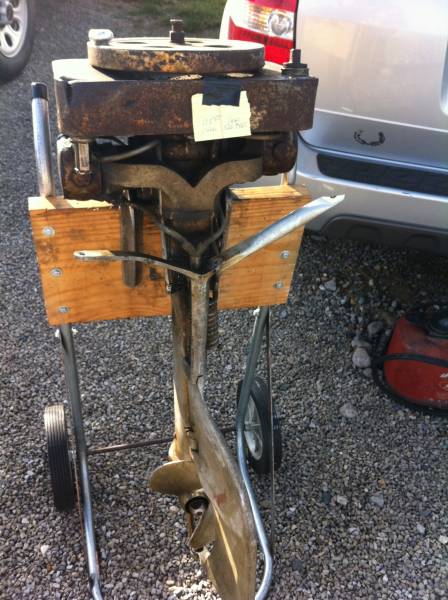 |
Note: Steering bar on top of rudder was rope controlled.
|
Restored Chris Craft Challenger
6 Motors - Chris Craft & Mercs
A Merc of a Different Color
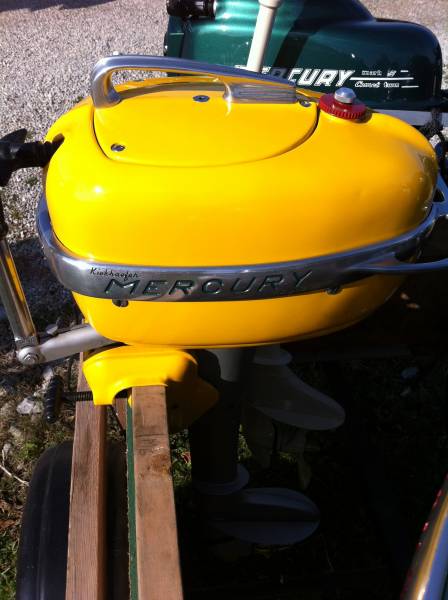 |
Taking just a wee bit of liberty with motor color.
|
Face Plate?
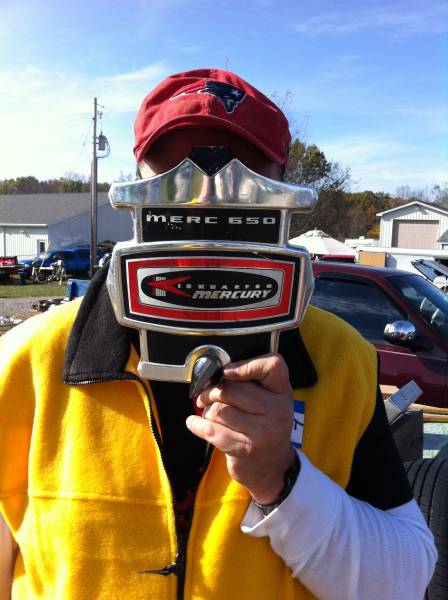 |
Well, they said it was a face plate!
|
Johnson & Elto
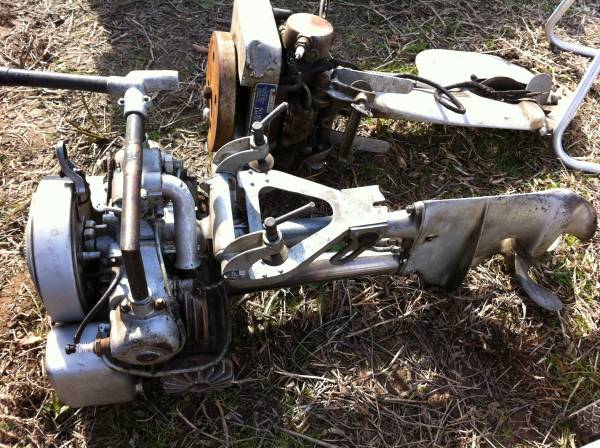 |
Johnson Twin in foreground, Elto Ruddertwin behind Johnson.
|
Caille Twin
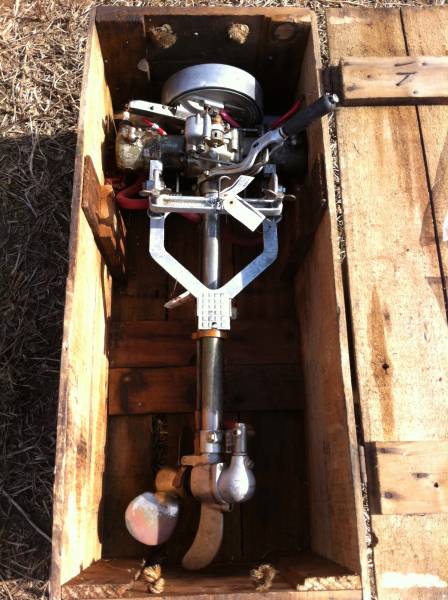 |
Caille Twin in a shipping crate (note the variable pitch prop).
|
Outboard Literature Display
Scott-Atwater Twin
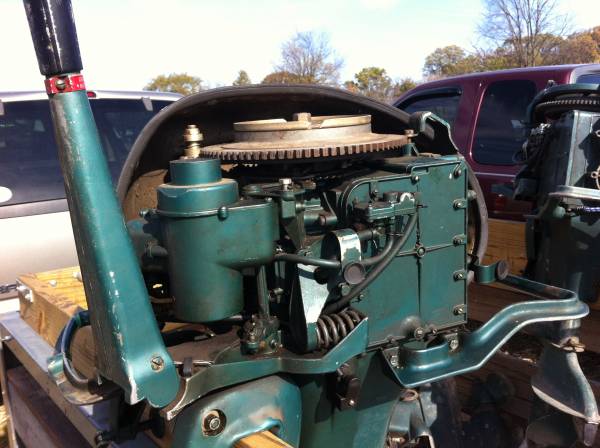 |
Scott-Atwater Twin with port-side cowl off.
|
Host, Mark Suter, Grabbing some Chow
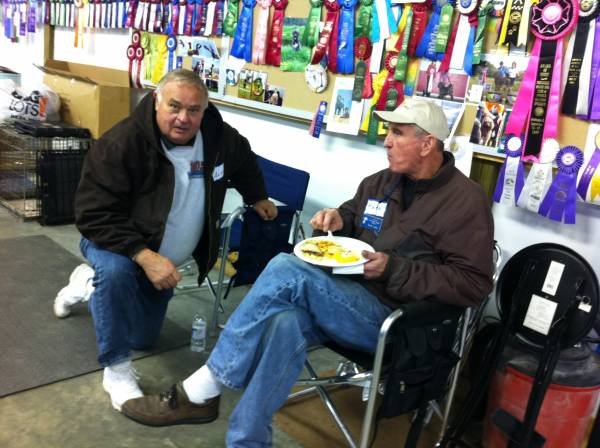 |
Mark Suter is the gentleman on the right.
|
Caille Racing Motor with Tractor Lower Unit
Mercury Lightning
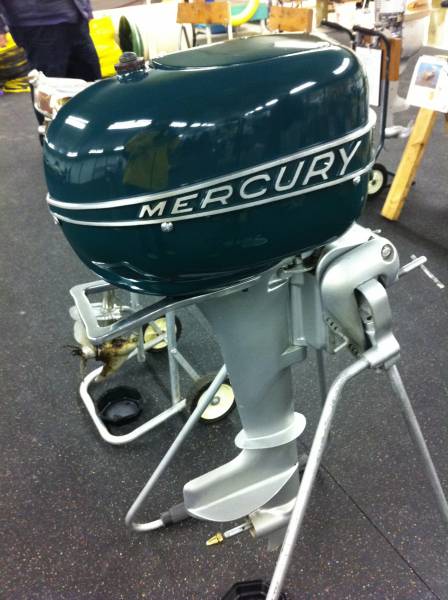 |
Concours Mercury "Lightning" with accessory carrying handle at top of tower.
|
Johnson Single Motor
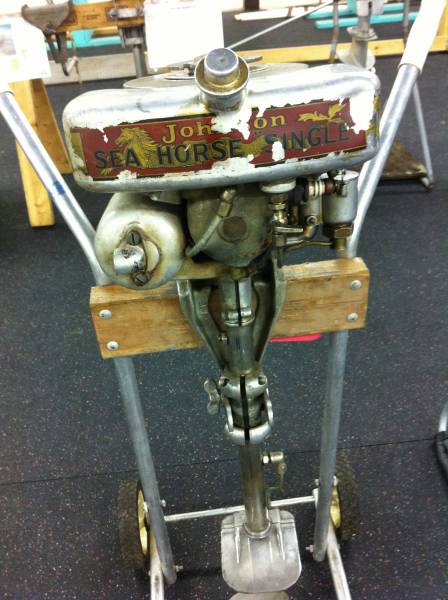 |
An original, early Johnson single motor.
|
Restored Elto Imperial Light Four
Restored Mercury KG4H Class A-Stock Racer
Elgin 25 HP - Control Panel View
Water Witch 3/4 HP Motor
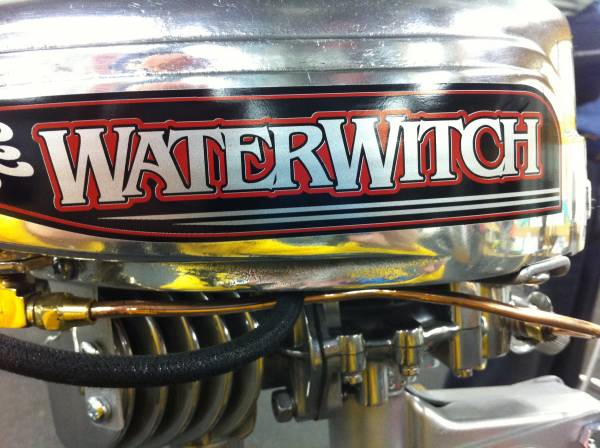 |
Concours Water Witch air-cooled 3/4 HP motor.
|
Start of the Awards Presentation
More Awards Presentations
More Awards Presentations
Gierholtt Motor
 |
Gierholtt shallow water motor that was originally owned by Charles Schilling, the designer of the motor. This motor has a non-standard water pump, fuel tank and an automotive type ignition coil (the water pump and fuel tank probably also designed by Schilling).
|
Gierholtt Motor (2)
 |
Underside of the Gierholtt motor showing the automotive coil that was added by some previous owner.
|
1986 B/C-Mod Runabout
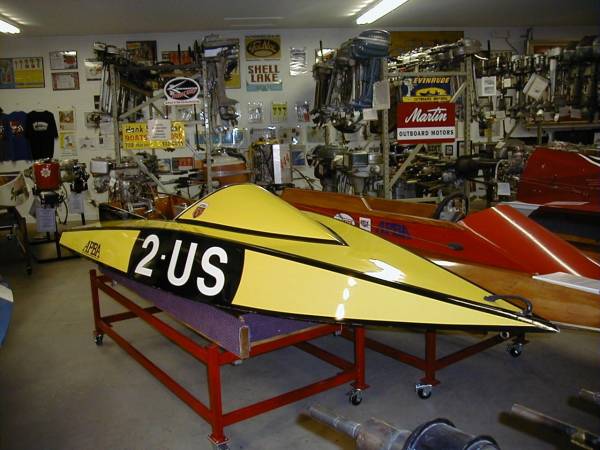 |
1986 Dale Ropp B/C-Mod Runabout boat that won numerous National Championships for Bill Breaux and Shawn Brill.
|
Johnson KR-55
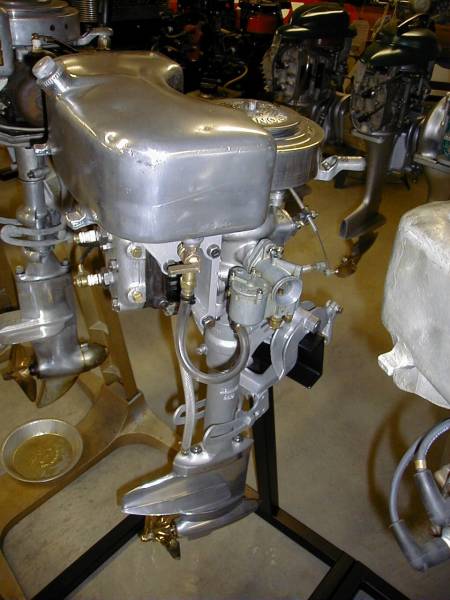 |
Johnson KR-55 raced by Bert Blaskie of Michigan. Bert won the Detroit Outboard Association season high points championship in 1952 in Class A "Alky" Hydro with this motor.
|
Johnson KR-55 (2)
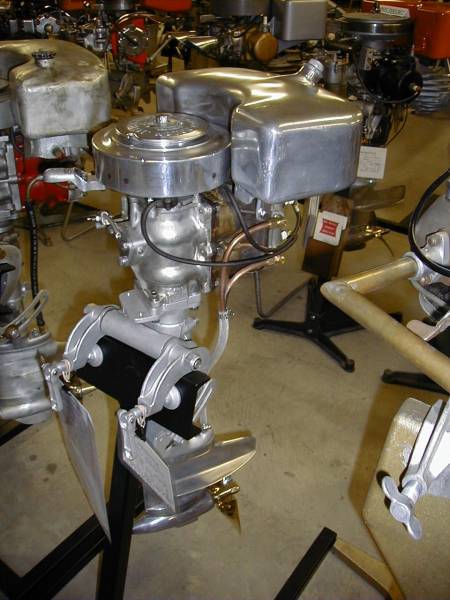 |
Another view of the Blaskie Johnson KR-55.
|
Butts & Wanamaker Quincy Loopers
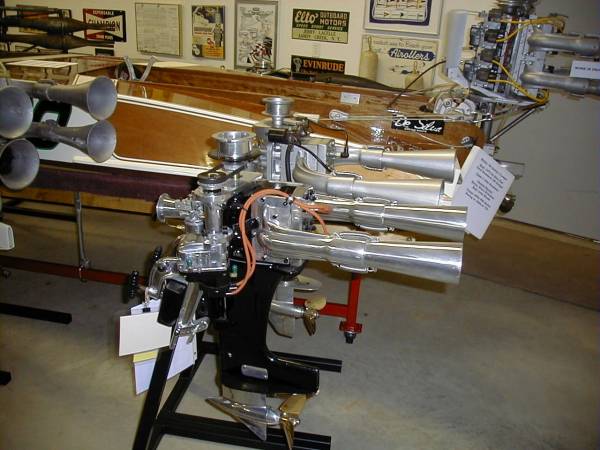 |
Class A Quincy Looper raced by Tim Butts, of Butts Aerowing Hydro fame, in the foreground and Class B Quincy Looper owned by Bill Wanamaker in the background.
|
1929 Caille Lightning Twins
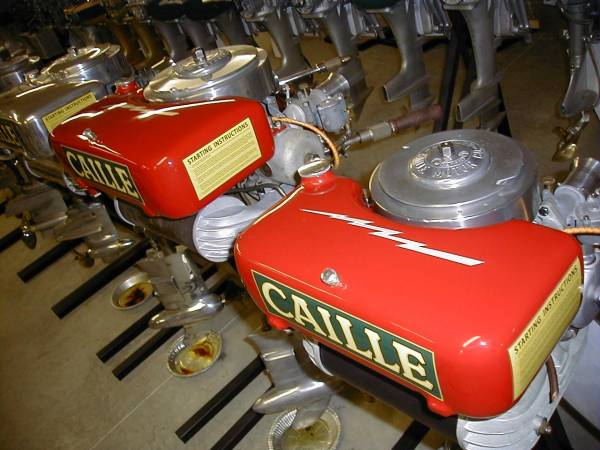 |
1929 Caille "Lightning Twins" with dual carburetors and tractor lower units. Note the lightning bolts across the tops of the tanks. Motor on the left is the 30 cubic inch class C "Streak" racer and on the right is the 20 cubinc inchc class B "Flash" racer.
|
1962 Konig FA Racer
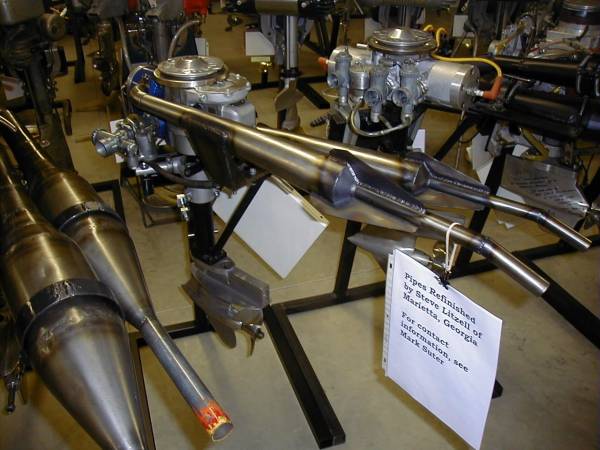 |
Early Konig FA Racer with pipes.
|
British Anzanis
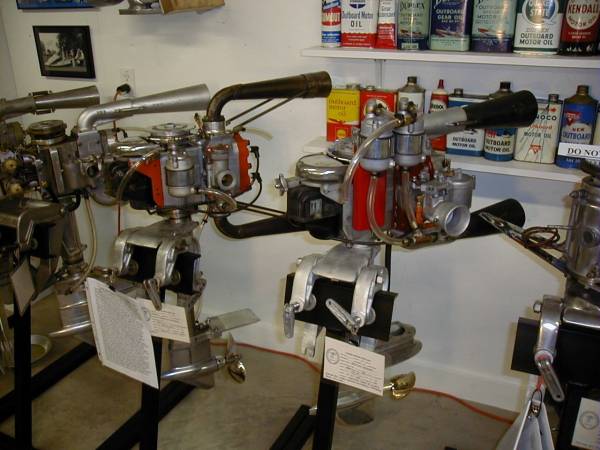 |
PRO class A and B British Anzanis that were raced by Bob Goller in the 1960s. Note that the A motor on the left sports a Mercury lower unit because the original Anzani unit was too prone to leakage.
|
PRO class B Harrison motor
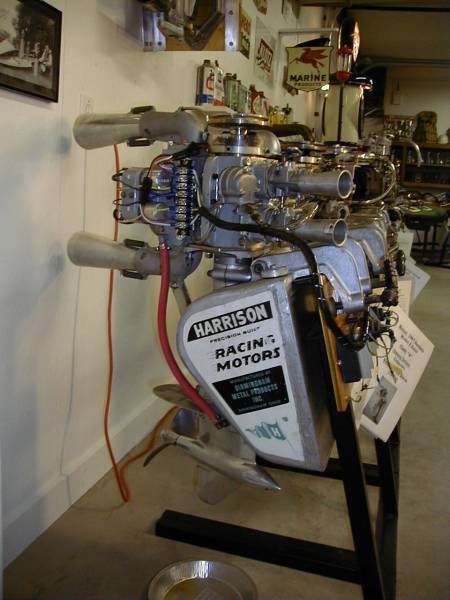 |
PRO class B Harrison motor (serial number 100) raced by Bob Goller. This was the 1st Harrison motor sold to a customer outside of the Harrison family. Note the saddle aluminum fuel tank and the four carburetors. Bob had a 5th carb at one time and it was mounted on the crankcase at an entry point to feed the rotary valve. At the time Bob stopped racing this motor (when the APBA announed the creation of the Mod racing class), Bob was just starting to install a Chrysler automotive electronic ignition system. Bob never completed that project, but he had purchased most of the necessary parts and had obtained a lengthened crankshaft to enable mounting the electronic triggers and reluctor under the flywheel. The ignition system installation was completed by Mark Suter to show Bob's intended "package." Another feature completed by Mark was the progressive throttle linkage based on Bob's best guess on what it would have taken to make the drivability of this multiple carb "beast" reasonably acceptable when transitioning from part to wide-open throttle.
|
2nd view - Goller Harrison motor
B-Mod Yamato 80 motor
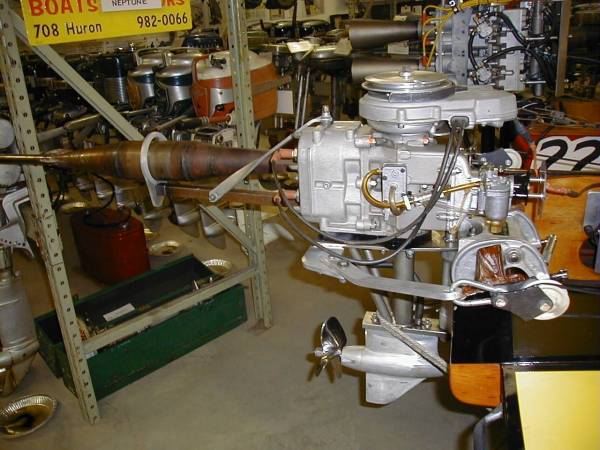 |
B-Mod Yamato 80 motor built by Bob Goller and raced by Kevin Fitzgerald of New York to a best-finish of 2nd place in a National Championship race. The motor is identical to those used by Bill Breaux to win several National Championships.
|
B-Mod Yamato 80 motor (2)
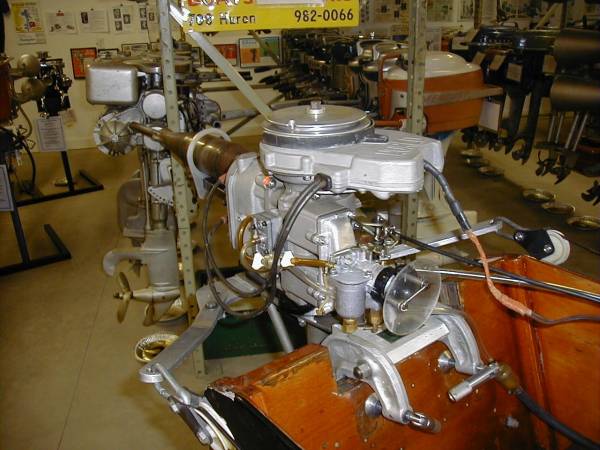 |
Another view of the Goller built B-Mod motor.
|
Rare Harrison 'Saxaphone' Exhuast System
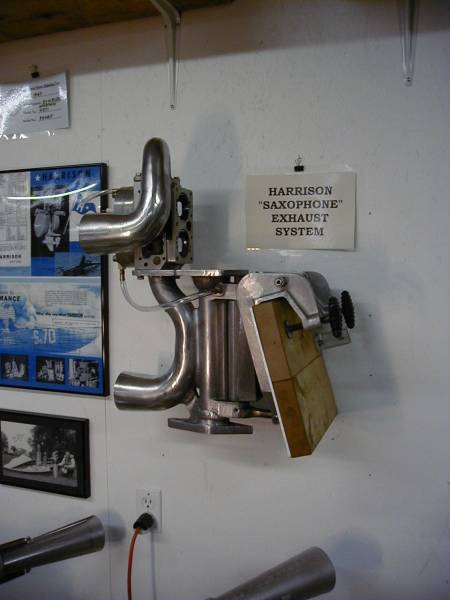 |
Rare Harrison "saxaphone" exhaust system for use with a Harrison lower unit. A spare cylinder block was used to locate the upper megaphone for display purposes. The system got it's name because the lower unit megaphone appears so similar to the musical instrument. The castings in this system were typically loaded with porosity and few were repaired and actually made it out onto a race course. Bob Goller extensively reworked this set with weld repairs to the point where it could have been used, but it never was run on a motor. Use on a motor would have necessitated relocation of the ignition coils due to coil interference with the upper exhaust megaphone.
|
2nd view - Harrison Sax Exhaust
Cailles with new Decals
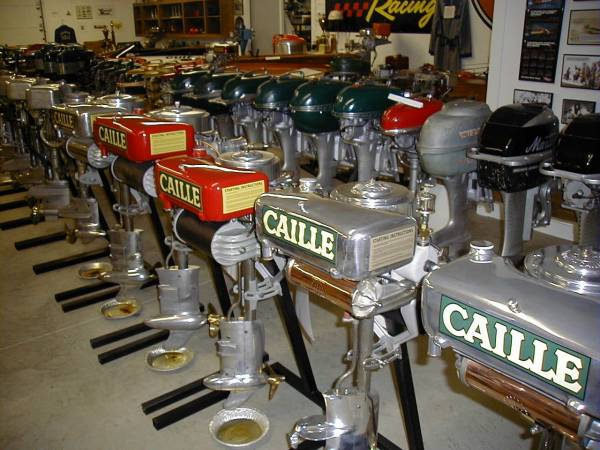 |
Most of the Caille racers in the Museum have been updated with new decals. Research and artwork on the decals were done by Randy Kallevig, the former AOMCI Special Interest Group Leader for the Caille motor brand. The colorful results are quite stunning.
|
Nicholson Quincy C Looper
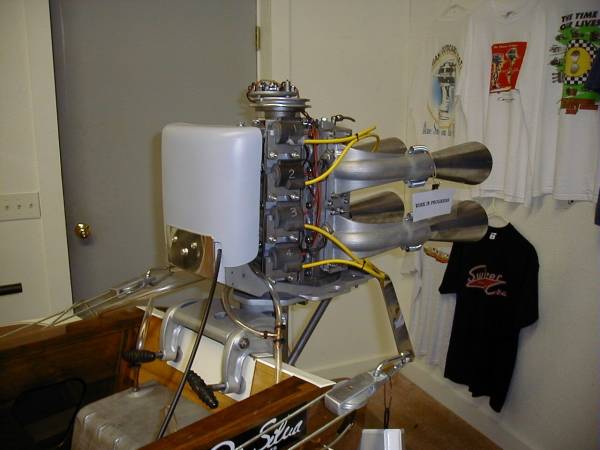 |
Bruce Nicholson's Quincy C Looper #FC62 as last raced, with a rare remote stator plate ignition system and an early Konig lower unit (stamped with the name "Watson"). This ignition system was sold either without or with the water shield (this motor was without... probably to enable getting the motor into racing quicker). The motor was completely locked up with castor residue, rust and white corrosion when found. It had been stored for many years in a barn by Phil Crown after it's last race and was rescued by Frank Novatny. It is still undergoing restoration and, as such, is labeled as a "work in progress." Bruce still vividly remembers this motor and reportedly said "I remember that motor very well... I rebuilt it in my motel room the night before a big race."
|
Nicholson Quincy C Looper (2)
 |
Port-side view of the Bruce Nicholson C Looper.
|
Nicholson Quincy C Looper (3)
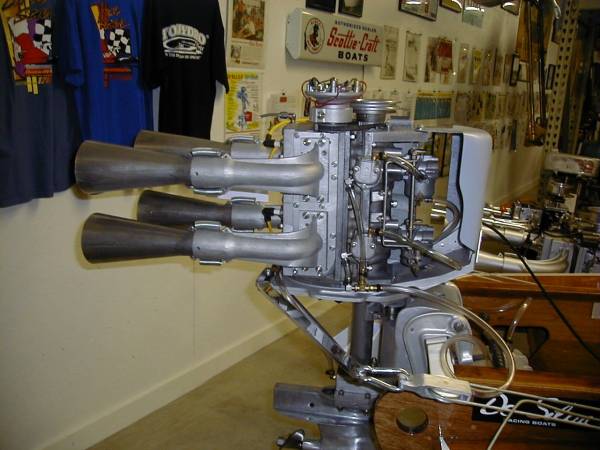 |
Port-side view of the Bruce Nicholson C Looper.
|
Parker Loopers
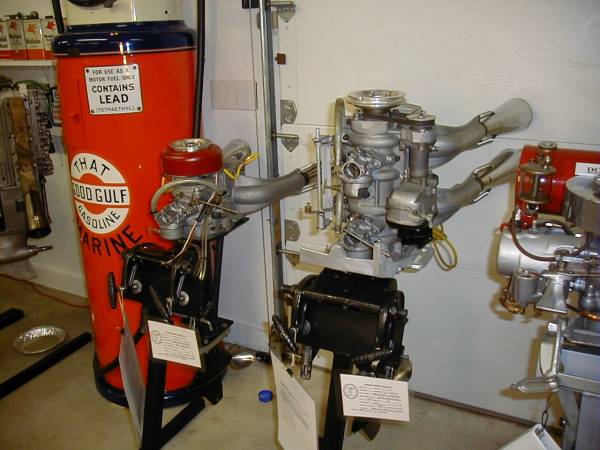 |
Rare Bud Parker Loopers. The class B twin on the left is one of only two built and the class D 4-cylinder is one of only six built (per Bud Parker). The Parker Loopers, like the Quincy versions, were based on Mercury architecture, cranks, rods, bearings, reeds, etc. but otherwise had unique Parker stick "towers" and used Mercury 1:1 lower units. The twin was raced by Jim Baady of Michigan and the four by Bud Parker. These motors were purchased from Dick Ollhoff of Wisconsin. (Dick had obtained them from Parker protégé, Tim Kurcz.)
|
Jerry Waldman class C Looper
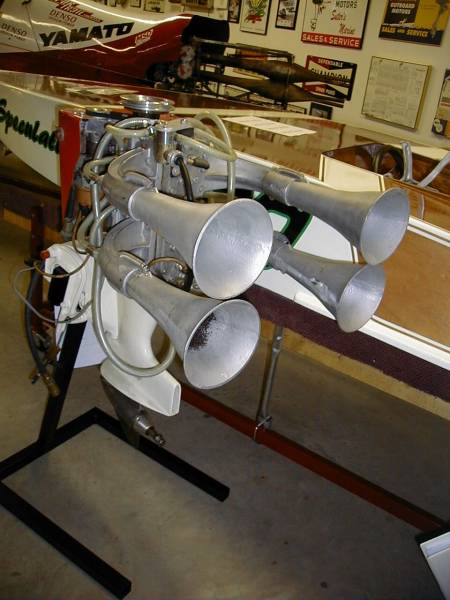 |
Jerry Waldman's class C Quincy Looper (#FC84) that won numerous National Championships, including one the day he was killed. Obvious Waldman motor features are the red water spray shield with the AC spark plug decal, the big bell exhaust megaphones and water injection system. The motor reportedly has a magnesium tower but that is yet to be verified. An original Quincy Welding dyno card shown with the motor reflects an exceptional level of performance (100.4 HP) for a class C motor, and it has been verified that this was NOT obtained with nitro-methane added to the fuel.
|
Jerry Waldman C Looper - front view
Jerry Waldman C Looper
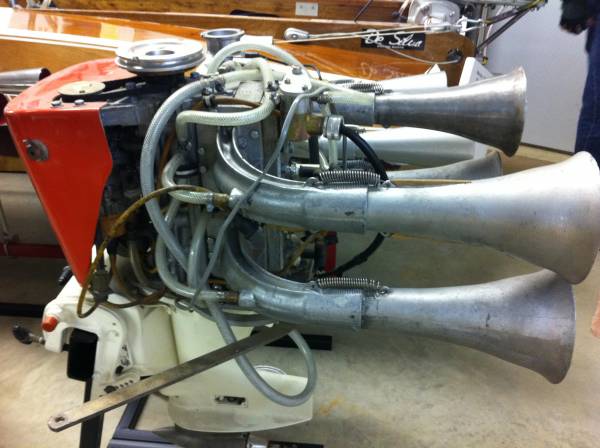 |
Side view of Jerry Waldman C Looper showing water injection system for exhaust tuning.
|
Waldman class C Looper (2)
Wayne Walgrave 6-cylinder Looper
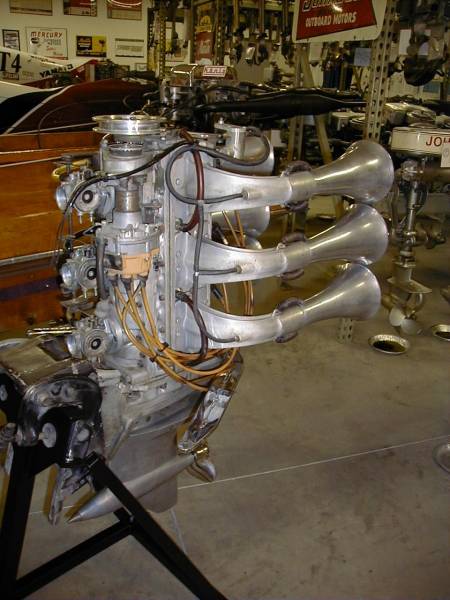 |
Wayne Walgrave's famous Quincy Looper #XF-41, raced 1971 through 1980. During that time period Walgrave racked up multiple State and National Championships and several High Point Championships. Walgrave raced the Quincy Looper on his homemade boat under the number G-71.
|
Display Board for Walgrave Looper
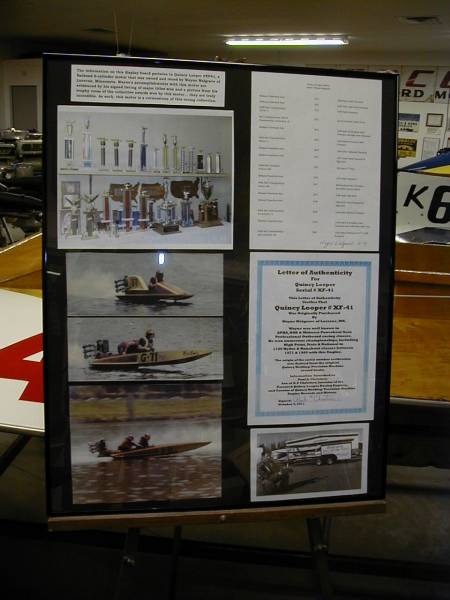 |
Display board featuring Walgrave's accomplishments with his 6-cylinder Quincy Looper.
|
Woods Runabout in the Quincy Corner
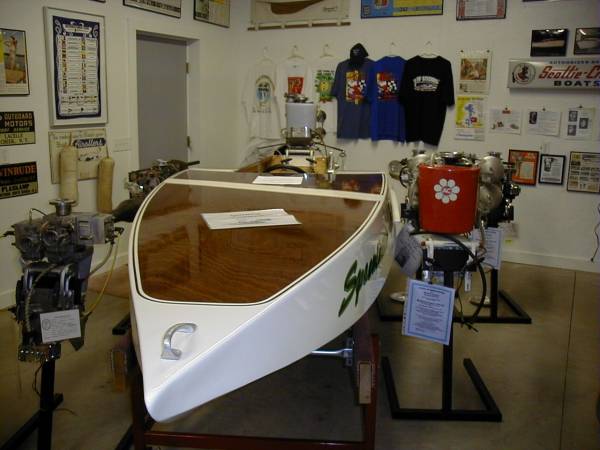 |
DeSilva flat-deck class C/D racing runabout owned by the late John Riner Woods of Missouri. John was a talented factory driver for Quincy Welding back in the 1960s and he raced a DeSilva runabout that was essentially identical to this boat. The name "Speculation" was chosen because John was a very successful stock broker and had a seat on the New York Stock Exchange. He won a lot of races for Quincy with the original boat. He later regretted parting with that boat so in 2005 he went back to DeSilva and asked them to build him a clone of the first one. They refused because the flat-deck design "was no longer being built." But John was not to be denied, so DeSilva reluctantly agreed and, immediately after completion of John's boat, they sent out a bulletin to their customers emphatically stating that they would not be building any more flat-deck runabouts. So this boat is confirmed to be the last flat-deck runabout built by DeSilva. The boat was displayed in a barn in Missouri until after John's tragic death in a motorcycle accident in 2008. It was later sold by his wife. It has never been in the water and never had a motor on it until now. It was originally outfitted with a full complement of DeSilva hardware. John added the Quincy "Vis-U-Matic" throttle. A quincy fuel tank was appropriately added to the rig when the motor was mounted.
|
Woods Runabout (2)
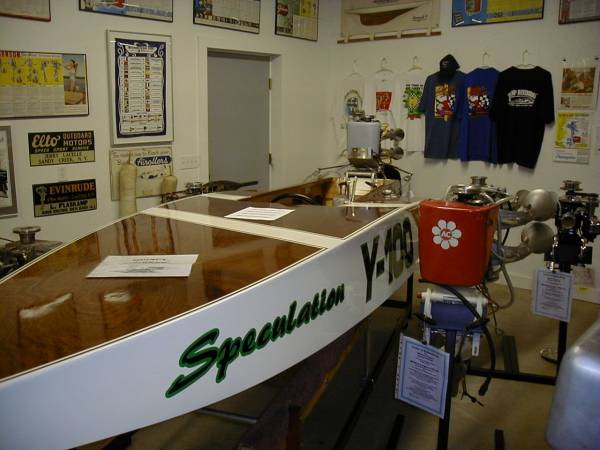 |
A second view of the John Woods flat-deck runabout.
|
Quincy Z Loopers
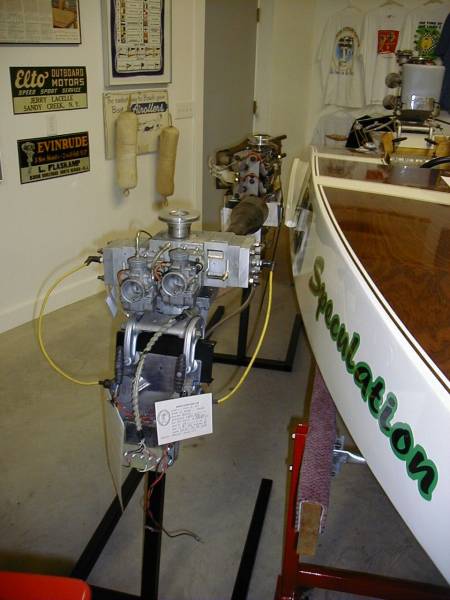 |
The motors on the starboard side of the John Woods runabout are second generation Quincy Loopers known as Quincy "Z" engines in honor of the late Harry Pasturzak (Zak) who helped O. F. and Paul Christner with the design of an improved Looper. The basic changes from the original Looper include more robust architecture, assembled crankshafts with one-piece connecting rods, pyramid reeds and sliding-pipe expansion chambers. The 1970s motors are a one-off prototype of a 250cc opposed twin in the foreground and an alternate-firing RB class twin in the background. Both motors were built by Larry Latta, who obtained a license from O. F. Christner to build Z motors. Larry ran the RB motor well into the 1990s and won a lot of races with it. The RB motor's victories over Konig rotary valve motors helped give credibility to Christner's contention that a reed valve motor with a good exhaust system could generate more horsepower than a good rotary valve engine because the reeds are open for a longer period of time.
|
|
|
